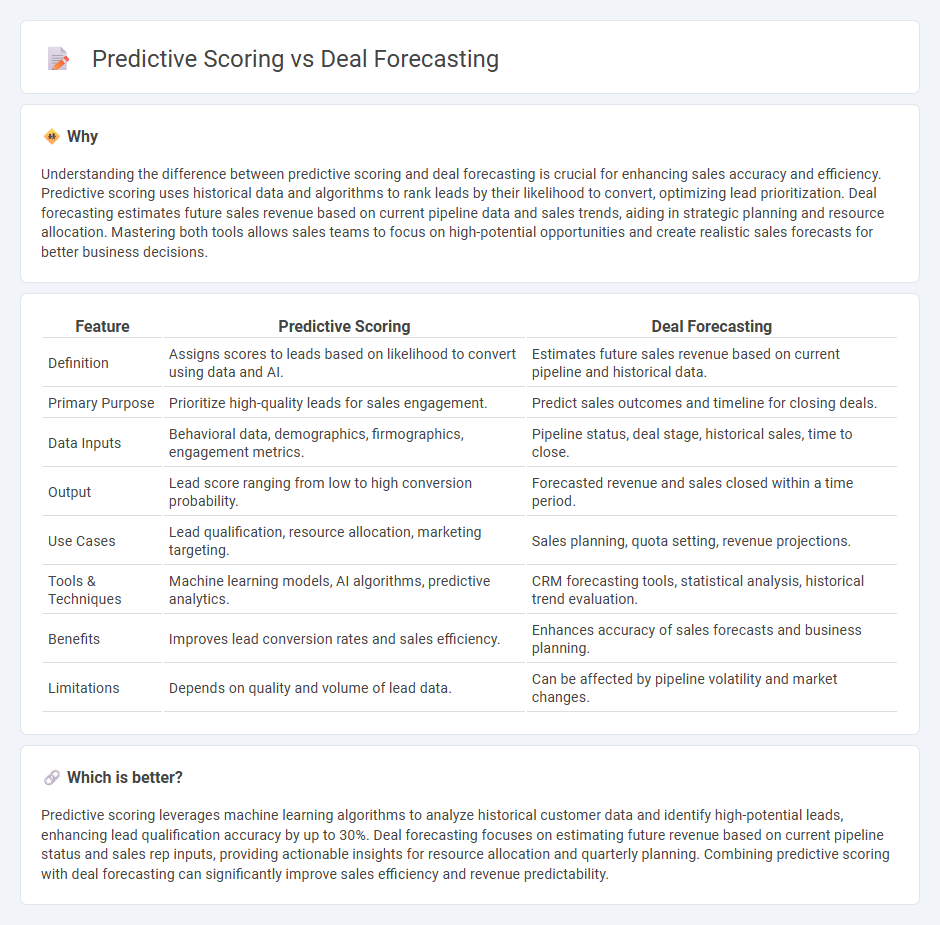
Predictive scoring leverages machine learning algorithms to analyze historical customer data and identify potential leads most likely to convert, optimizing sales prioritization. Deal forecasting focuses on estimating the probability of closing specific sales opportunities within a given period, helping sales teams allocate resources and set realistic revenue targets. Explore these techniques to enhance revenue accuracy and improve sales pipeline management.
Why it is important
Understanding the difference between predictive scoring and deal forecasting is crucial for enhancing sales accuracy and efficiency. Predictive scoring uses historical data and algorithms to rank leads by their likelihood to convert, optimizing lead prioritization. Deal forecasting estimates future sales revenue based on current pipeline data and sales trends, aiding in strategic planning and resource allocation. Mastering both tools allows sales teams to focus on high-potential opportunities and create realistic sales forecasts for better business decisions.
Comparison Table
| Feature | Predictive Scoring | Deal Forecasting |
|---|---|---|
| Definition | Assigns scores to leads based on likelihood to convert using data and AI. | Estimates future sales revenue based on current pipeline and historical data. |
| Primary Purpose | Prioritize high-quality leads for sales engagement. | Predict sales outcomes and timeline for closing deals. |
| Data Inputs | Behavioral data, demographics, firmographics, engagement metrics. | Pipeline status, deal stage, historical sales, time to close. |
| Output | Lead score ranging from low to high conversion probability. | Forecasted revenue and sales closed within a time period. |
| Use Cases | Lead qualification, resource allocation, marketing targeting. | Sales planning, quota setting, revenue projections. |
| Tools & Techniques | Machine learning models, AI algorithms, predictive analytics. | CRM forecasting tools, statistical analysis, historical trend evaluation. |
| Benefits | Improves lead conversion rates and sales efficiency. | Enhances accuracy of sales forecasts and business planning. |
| Limitations | Depends on quality and volume of lead data. | Can be affected by pipeline volatility and market changes. |
Which is better?
Predictive scoring leverages machine learning algorithms to analyze historical customer data and identify high-potential leads, enhancing lead qualification accuracy by up to 30%. Deal forecasting focuses on estimating future revenue based on current pipeline status and sales rep inputs, providing actionable insights for resource allocation and quarterly planning. Combining predictive scoring with deal forecasting can significantly improve sales efficiency and revenue predictability.
Connection
Predictive scoring analyzes historical sales data and customer behavior to assign a probability score indicating the likelihood of closing a deal. Deal forecasting leverages these predictive scores to create accurate revenue projections and guide sales team strategies. Integrating predictive scoring with deal forecasting enhances decision-making by prioritizing high-potential opportunities and optimizing resource allocation.
Key Terms
**Deal Forecasting:**
Deal forecasting leverages historical sales data, current pipeline stages, and market trends to estimate revenue potential and close probabilities, enabling sales teams to allocate resources effectively. By analyzing deal velocity, buyer engagement, and win rates, it provides a quantifiable projection of future sales performance, enhancing decision-making accuracy. Explore more on how deal forecasting can transform your sales strategy and optimize revenue outcomes.
Pipeline Stage
Deal forecasting leverages historical sales data and trend analysis to estimate future revenue within each pipeline stage, enabling accurate sales projections. Predictive scoring uses machine learning algorithms to assign likelihood scores to deals based on attributes like customer behavior, deal size, and engagement levels, enhancing prioritization in pipeline stages. Explore detailed strategies to optimize your pipeline management with deal forecasting and predictive scoring insights.
Close Probability
Deal forecasting estimates the likelihood of a sales deal closing based on historical sales data, pipeline stages, and sales team input, providing a macro-level view of revenue potential. Predictive scoring uses machine learning algorithms to analyze numerous factors such as customer behavior, engagement metrics, and past purchasing patterns to assign a close probability score to individual deals. Explore how combining deal forecasting with predictive scoring can enhance sales accuracy and optimize resource allocation.
Source and External Links
Examining 6 sales forecasting methods - This guide explores six proven sales forecasting methods, including opportunity-stage forecasting and others, to help predict sales efficiently.
Sales Forecasting Examples That Actually Work - This article provides examples of advanced stage forecasting with time-in-stage analysis to improve forecast accuracy by considering deal velocity.
The definitive guide to sales forecasting methodologies - This guide outlines essential sales forecasting techniques such as opportunity stages forecasting, which helps predict sales by evaluating deal stages.
 dowidth.com
dowidth.com